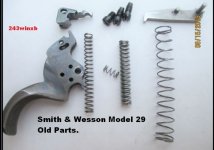Caution.....there is zero "engineering" or science that follows, only my opinion.
Take it with a grain of salt, as we used to say.
One of the main issues with the cylinder unlocking during recoil in the high power revolvers like the model 29 is the inherent instability caused, in part, by the design of the cylinder stop.
The S&W cylinder stop, by design, moves in four directions on the frame stud when in contact with the trigger....down, up, forward and backward. These motions are accommodated by the space provided in the frame cavity, and the cylinder stop itself, and are caused by the trigger hook as it moves down during the trigger rearward pull, and back up, as the trigger returns and the hook moves up over the stop bevel.
The unlocking problem occurs when the trigger is back and the cylinder stop is in battery, inside the cylinder stop slot in the cylinder. When the revolver fires (under heavy recoil), the frame cams to the left, moves forcibly back, and the cylinder stop "moves forward" on the stop's frame stud. (overcoming the pressure supplied by the stop spring) At this point, and because the ball of the cylinder stop has moved forward (out of) in it's position in the cylinder slot, the cylinder may cam off of the cylinder stop, and out of the stop slot in the cylinder. The result is that the proper timing of the next trigger pull is interrupted, as the cylinder/extractor assembly is not in the correct position to be acted upon by the trigger/hand movement. If the hand picks the cylinder up at all, it is rotated back to the chamber that just fired.
An additional problem is that the actual shape of the stop can contribute to the malfunction. The stop ball is rounded on top to conform to the slot in the cylinder. Guess what, as the stop moves forward under heavy recoil, it literally cams itself down and out of the cylinder slot.
And, if you look closely at the cylinder stop, between the ball of the stop and the adjustment step on the stop body there is a raised/angled area in the neck that can come into contact with the front edge of the stop's frame slot window. The angle here can cause the stop to move down (out of the cylinder slot) during very heavy recoil.
Add in the other possible manufacturing and fitting variances involved, including stop fitting during assembly, where the stop may be left at a point not high enough in the frame to fully engage (bottom out) the cylinder slot, and the instability problem is exacerbated.
Replacing the stop spring with the heavier Wolff spring can help mitigate this issue, along with using "conventional" or factory loadings.

Carter






